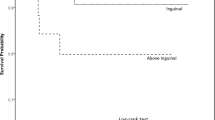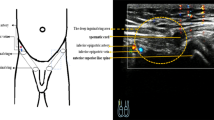Abstract
Cryptorchidism is one of the most common genitourinary disorders in young boys. Although the management of boys with palpable testis is standardized, there are no formal guidelines for the management of boys with nonpalpable testis. In this Review we look at the current trends in the diagnosis and treatment of this disorder, as well as the indications for therapy and surgical procedures. On the basis of current evidence, we find that there is no optimum orchidopexy technique for the treatment of intra-abdominal testis, although it is preferable to adopt techniques that preserve the spermatic vessels. We also briefly examine the follow-up of patients with this disorder and its common complications. As yet, there are no data that assess the potential of laparoscopic orchidopexy being a risk factor for impaired fertility later in life.
Key Points
-
Undescended testis is one of the most common congenital abnormalities of the genitourinary system; about 20% are nonpalpable
-
Ultrasonography in unnecessary in most cases of unilateral nonpalpable testis
-
Diagnostic laparoscopy seems to be the gold standard for the exploration for nonpalpable undescended testicles
-
On the basis of current evidence, there is no optimum orchidopexy technique for the treatment of intra-abdominal normotrophic testis, although empirically it is preferable to adopt techniques that spare the spermatic vessels
-
There is a need for long-term follow-up and multicentric prospective studies that evaluate the various laparoscopic approaches
This is a preview of subscription content, access via your institution
Access options
Subscribe to this journal
Receive 12 print issues and online access
$209.00 per year
only $17.42 per issue
Buy this article
- Purchase on Springer Link
- Instant access to full article PDF
Prices may be subject to local taxes which are calculated during checkout

Similar content being viewed by others
References
Bloom DA (1991) Two-step orchiopexy with pelviscopic clip ligation of the spermatic vessels. J Urol 145: 1030–1033
Chang B et al. (2001) Laparoscopic orchidopexy: a review of a large clinical series. BJU Int 87: 490–493
Jordan GH (1997) Will laparoscopic orchiopexy replace open surgery for the nonpalpable undescended testis? J Urol 158: 1956–1958
Kirsch AJ et al. (1998) Surgical management of the nonpalpable testis: the Children's Hospital of Philadelphia experience. J Urol 159: 1340–1343
Sweeney DD et al. (2007) Minimally invasive surgery for urologic disease in children. Nat Clin Pract Urol 4: 26–38
Swerdlow AJ et al. (1997) Risk of testicular cancer in cohort of boys with cryptorchidism. BMJ 314: 1507–1511
Hadziselimovic F and Herzog B (1997) Treatment with a luteinizing hormone-releasing hormone analogue after successful orchiopexy markedly improves the chance of fertility later in life. J Urol 158: 1193–1195
Esposito C and Garipoli V (1997) The value of 2-step laparoscopic Fowler–Stephens orchiopexy for intra-abdominal testes. J Urol 158: 1952–1954
Fleet ME et al. (1999) Emerging trends in the management of the impalpable testis. Br J Surg 86: 1280–1282
Elder JS (1992) Two-stage Fowler–Stephens orchiopexy in the management of intra-abdominal testes. J Urol 148: 1239–1242
Canavese F et al. (1995) Non palpable testes: orchiopexy at single stage. Eur J Pediatr Surg 5: 104–107
Docimo SG (1995) The results of surgical therapy for cryptorchidism: a literature review and analysis. J Urol 154: 1148–1152
Fowler R and Stephens FD (1959) The role of testicular vascular anatomy in the salvage of the high undescended testis. Aust N Z J Surg 29: 92–96
Alam S and Radhakrishnan J (2003) Laparoscopy for the nonpalpable testis. J Pediatr Surg 38: 1534–1536
Cortesi N et al. (1976) Diagnosis of bilateral abdominal cryptorchidism by laparoscopy. Endoscopy 8: 33–34
Humphrey GM et al. (1998) Laparoscopy in the management of the impalpable undescended testis. Br J Surg 85: 983–985
Weiss RM et al. (1986) High resolution real-time ultrasonography in the localization of the undescended testis. J Urol 135: 936–938
Elder JS (2002) Ultrasonography is unnecessary in evaluating boys with a nonpalpable testis. Pediatrics 110: 748–751
Esposito C et al. (2003) Complications of pediatric urological laparoscopy: mistakes and risks. J Urol 169: 1490–1492
Poppas DP and Lemack GE (1996) Laparoscopic orchiopexy: clinical experience and description of technique. J Urol 155: 708–711
Stéfaniu M et al. (2004) Laparoscopic surgery for undescended testicles [French]. Arch Pediatr 11: 315–318
Cisek LJ et al. (1998) Current findings in diagnostic laparoscopic evaluation of the nonpalpable testis. J Urol 160: 1145–1149
Yeung CK et al. (1999) A new management algorithm for impalpable undescended testis with gadolinium enhanced magnetic resonance angiography. J Urol 162: 998–1002
El-Anany F et al. (2007) Laparoscopy for impalpable testis: classification-based management. Surg Endosc 21: 449–454
Esposito C et al. (2000) Laparoscopic orchiopexy without division of the spermatic vessels: can it be considered the procedure of choice in case of intraabdominal testis? Surg Endosc 14: 658–660
Frey P and Bianchi A (1989) Microvascular autotransplantation of intra-abdominal testes. Prog Pediatr Surg 23: 115–125
Caldamone AA and Amaral JF (1994) Laparoscopic stage 2 Fowler–Stephens orchiopexy. J Urol 152: 1253–1256
Dhanani NN et al. (2004) Successful outpatient management of the nonpalpable intra-abdominal testis with staged Fowler–Stephens orchiopexy. J Urol 172: 2399–2401
Rozanski TA et al. (1996) The remnant orchiectomy. J Urol 155: 712–713
Taran I and Elder JS (2006) Results of orchiopexy for the undescended testis. World J Urol 24: 231–239
Tackett LD et al. (2002) The high intra-abdominal testis: technique and long-term success of laparoscopic testicular autotransplantation. J Endourol 16: 359–361
Esposito C et al. (2003) Comparison between five different hormonal treatment protocols for children with cryptorchidism. Scand J Urol 7: 345–348
Schwentner C et al. (2005) Neoadjuvant gonadotropin-releasing hormone therapy before surgery may improve the fertility index in undescended testes: a prospective randomized trial. J Urol 173: 974–977
Sahin C et al. (2002) The effects of one- and two-stage orchiopexy on postoperative serum testosterone levels and testicular volume in adult patients with bilateral nonpalpable testes. J Laparoendosc Adv Surg Tech A 12: 327–331
Bukowski TP et al. (1995) Testicular autotransplantation: a 17-year review of an effective approach to the management of the intra-abdominal testis. J Urol 154: 558–561
Cendron M et al. (1989) Cryptorchidism, orchiopexy and infertility: a critical long-term retrospective analysis. J Urol 142: 559–562
El-Gohary A (2003) Two stage laparoscopic Fowler–Stephens procedure for high abdominal testis. Saudi Med J 24: 30–33
Jordan GH and Winslow BH (1994) Laparoscopic single stage and staged orchiopexy. J Urol 152: 1249–1252
Youngson GG and Jones PF (1991) Management of the impalpable testis: long-term results of the preperitoneal approach. J Pediatr Surg 5: 618–620
King LR (1998) Orchiopexy for impalpable testis: high spermatic vessel division is a safe maneuver. J Urol 160: 2457–2460
O'Brien MF et al. (2004) One-stage Fowler–Stephens orchidopexy for impalpable undescended testis. Ir J Med Sci 173: 18–19
Law GS et al. (1997) Two-stage Fowler–Stephens orchiopexy with laparoscopic clipping of the spermatic vessels. J Urol 158: 1205–1209
Lindgren BW et al. (1998) Laparoscopic orchiopexy: procedure of choice for the nonpalpable testis? J Urol 159: 2132–2135
Giuliani L and Carmignani G (1983) Microsurgical testis autotransplantation: a critical review. Eur Urol 9: 129–132
Harrison CB et al. (1990) Microvascular autotransplantation of the intraabdominal testis. J Urol 144: 506–509
Zenaty D et al. (2006) Bilateral anorchia in infancy: occurrence of micropenis and the effect of testosterone treatment. J Pediatr 149: 687–691
Radmayr C et al. (2003) Long-term outcome of laparoscopically managed nonpalpable testes. J Urol 170: 2409–2411
Rosito NC et al. (2004) Volumetric and histological findings in intra-abdominal testes before and after division of spermatic vessels. J Urol 171: 2430–2433
Krabbe S et al. (1979) High incidence of undetected neoplasia in maldescended testes. Lancet 15: 999–1000
Baker LA et al. (2001) A multi-institutional analysis of laparoscopic orchidopexy. Br J Urol 87: 484–489
Acknowledgements
Désirée Lie, University of California, Irvine, CA, is the author of and is solely responsible for the content of the learning objectives, questions and answers of the Medscape-accredited continuing medical education activity associated with this article.
Author information
Authors and Affiliations
Corresponding author
Ethics declarations
Competing interests
The authors declare no competing financial interests.
Rights and permissions
About this article
Cite this article
Esposito, C., Caldamone, A., Settimi, A. et al. Management of boys with nonpalpable undescended testis. Nat Rev Urol 5, 252–260 (2008). https://doi.org/10.1038/ncpuro1102
Received:
Accepted:
Published:
Issue Date:
DOI: https://doi.org/10.1038/ncpuro1102
This article is cited by
-
Laparoscopic staged spermatic vessel-sparing procedure for intra-abdominal undescended testis
Journal of Pediatric Endoscopic Surgery (2020)
-
Minimalinvasive Chirurgie im Kindesalter
Der Chirurg (2016)
-
What is the ideal surgical approach for intra-abdominal testes? a systematic review
Pediatric Surgery International (2015)



